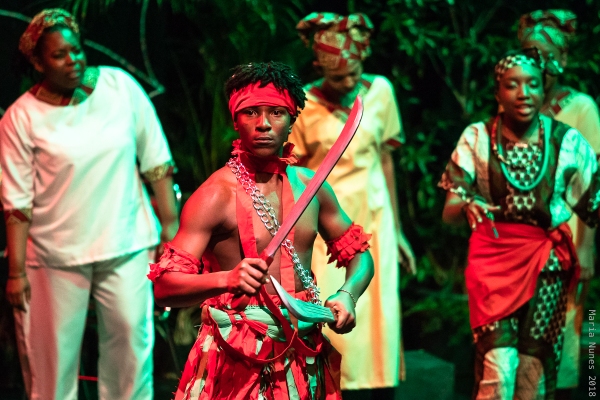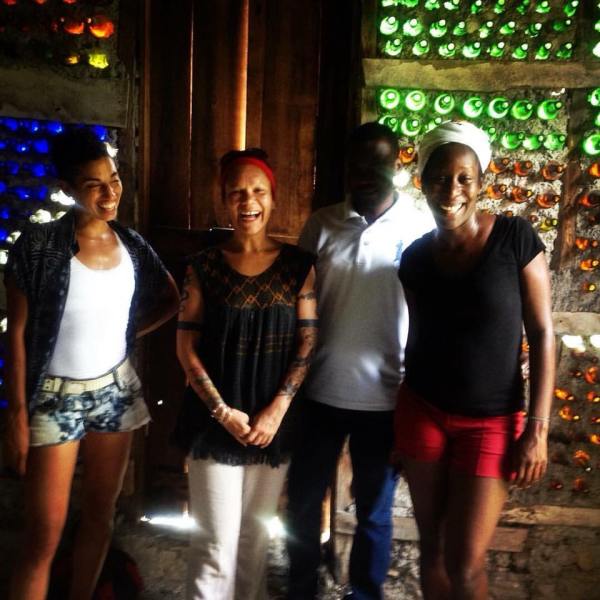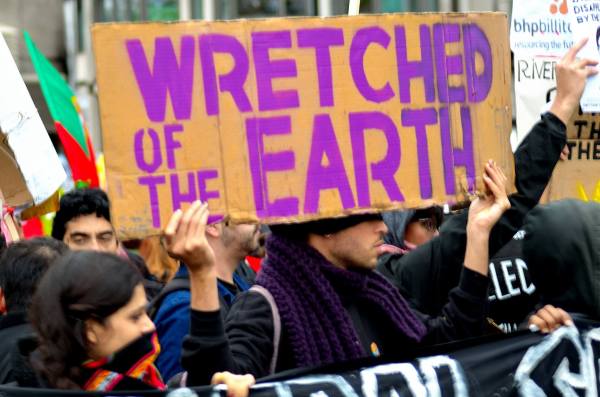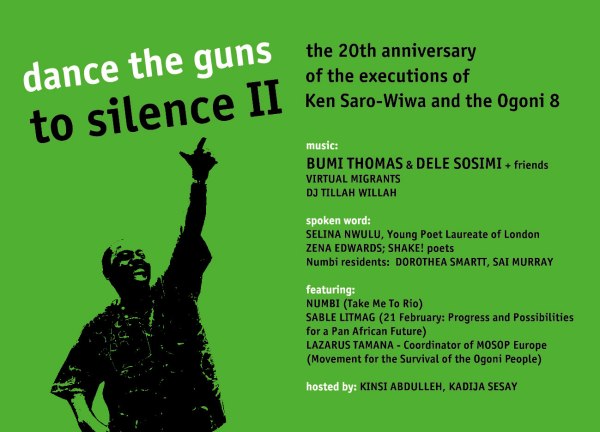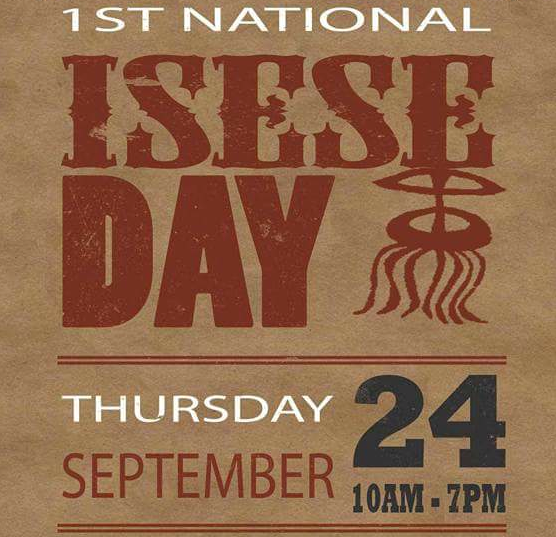Why, in the past ten years, have we seen a resurgence of the moko jumbie? It can’t just be that we like to see people walking on stilts.
Maybe this is the mas we need the most now. It is ancient memory living powerfully now. It is a ubiquitous mas of protection and healing found throughout East, West and Central Africa.
The fact that so many of our children, our young people are drawn to this jumbie mas is part of the obeah of this moment, when all our protective institutions are failing us, when our schools are little more than holding centres, when the natural curious mischief of childhood gets co-opted by cynical hardened criminal elements.
We need this mas now more than ever, not only because we need spiritual healing but also because our arts can save us from the despair that we want to wallow in. Act like a moko jumbie. Rise above, find your balance, see further, keep walking.
Dear Media People, a few things about Obeah that Trevor Sayers can’t tell you
1. Many spiritual systems across the world believe that plants, animals, stones, wood, trees, geographical locations etc have an energy frequency and that you can use these to move yourself or others closer to or further away from balance. This belief does not just exist in African spiritual systems.
2. Vodou is a Fon/Ewe word meaning spirit. It is a religious body of beliefs practiced in Benin and it exists in a syncretic form with Catholicism in Haiti. Voodoo is anti-Black propaganda made up by Hollywood to further separate African people from their spirituality. The specific fear around Haitian spirituality stems from the fact that Vodou was a central part of the success of the Haitian Revolution.
3. There are multiple considerations of the origin of the word ‘Obeah’ similar or root words exist in Twi, Efik, Akan…but what we know of Obeah is a sloppy colonialist lumping together of complex spiritual systems that they did not understand but that they feared would be used by enslaved people to emancipate themselves.
4. Obeah was criminalised in the Caribbean because it was a tool of resistance, the first Obeah laws appeared in 1760 after Tacky’s Rebellion in Jamaica. You should also know that in 2015 three Hindu men were arrested and deported from Antigua under the Obeah Act of 1904.
5. Obeah is not Ifa/Orisa. However Ifa/Orisa devotees believe that all natural elements have a vibrational force that can be harnessed to achieve certain outcomes for the person requesting the ritual, or the intended receiver of the effects of the ritual.
6. All systems can be used for both positive and negative, if you believe in these polarities. Political, educational, spiritual systems around the world have since the dawn of humanity been created and interpreted by those who have more information to manipulate those who have less information.
7. The only thing that can hurt us is fear of what we don’t understand. If people know that we are afraid of certain ways of being and seeing the world they have power over us. This has nothing to do with spiritual forces. The perception of power is created and can be distorted by those who stand to benefit from keeping people in a state of fear.
8. If you know your own obeah, nobody can use theirs against you.
Discussions, Performances, Street Parade for 2018 Ogun Festival October 5-7
A new play written by Eintou Pearl Springer on the Orisa Ogun will be part of the programme for this year’s Ogun Festival, a three day festival celebration of the Yoruba deity Ogun at the Ile Isokan compound Niles Trace Febeau Village, Lower Santa Cruz from October 5-7, 2018.
Inside the healing house
After the 2010 earthquake a small house was made out of rubble, wood and glass bottles. There is an altar and the sun filtered through the walls of blue, green bottles bathes the inside of the house in silence and light. The healing house is an important part of the post-earthquake recovery. It is a reminder that natural disasters require not just reconstruction of buildings but reconstruction of emotional, spiritual, mental stability. I’ve been thinking a lot about Haiti in these days following our own earthquake encounter. Like everyone else here I’ve made jokes while freaking out silently. Haiti we know has more than 200 years of staring war, tragedy, devastation and disaster in the face and managing somehow to emerge and find ways to keep going. I’m not so sure about T&T. We continue to fool ourselves that God is a Trini and that absolves us from adopting a more proactive stance on many things. It also means we take a lax approach to the mental health implications of natural and human disasters. In addition to being mindful of our building codes, we also need to be aware that humans will need to be checked for cracks and damage too.
Help Haitians, not the Disaster Capitalists
Disaster time again, for our sisters and brothers in Haiti. Already the vultures circle, using this tragedy as another opportunity to take advantage or worse, to engage in the pornography of suffering black bodies.
Now is not the time for tears, hand-wringing, there are lots of organisations that are quietly doing good work in Haiti that does not line the pockets of multinational aid corporations, or continue to fatten the Port au Prince elite.
The following is a list I’ve compiled thanks to friends in Haiti and its diaspora. Please do your own research on the organisations listed below. I’ll keep updating it as more info emerges.
Donations in Trinidad
A group of citizens are doing a non-organisational collection of items from Monday 10th October. Collection/Drop-off point will be at the Veni Mangé Restaurant 67A Ariapita Ave, Woodbrook.
ITNAC Trinidad based organisation sending volunteers soon to Haiti asking for donations of food/clothing/shoes/women’s sanitary wear/insect repellent as well as urgent cash donations in any currency.
Haitian led NGOs
Konbit Mizik a NYC based non-profit using music to educate, empower and uplift Haiti’s vulnerable youth.
Haiti Communitiere Donations go directly to help communities gain access to the resources, knowledge and skills they need to rebuild.
Art Creation Foundation for Children (ACFFC) is an arts based non-profit organization created for the personal growth, empowerment, and education of children in need in Jacmel, Haiti.
Sakala provides a safe space in the heart of Haiti’s largest underdeveloped area, where youth come together to grow, learn, and play.
Soil Haiti eco sanitation service organisation
Volontariat pour le Développement d’Haïti focusing on young people’s development
Lambi Fund working on economic justice and alternative sustainable development.
MADRE LGBTQI friendly organisation doing gender discrimination and violence work.
Sowaseed Sustainable change and support for orphans
Konbit Solèy Leve Participation, Solidarity, Reciprocity
Haitian American Caucus Brooklyn based young professionals organisation
PRODEV Education access in under-served communities.
Ayiti Se NOU Working on various projects around education, health, environment, entrepreneurship and culture/sports.
International NGOs
Roots of Development community led development projects
Partners in Health Teaching Hospital in Mirebalais
Nova Hope for Haiti community medical care
Crowd-funding appeals
Fondation Aquin Solidarite (FAS) is a non-profit organization, founded in 2005, to provide educational, cultural, sports and economic support and mentoring to the city and the people of Aquin, located 117kms southwest of Port-au-Prince.
Hurricane Matthew Relief in Abricots Support for cacao farmers in Abricots organised by dance scholar Dasha Chapman.
Donations in NYC
Flatbush-YMCA at 1401 Flatbush; the Multicultural Bridge Project at 1894 Flatbush Ave.; and the Haitian Family Resource Center at 1783 Flatbush Ave.
Quiescere Resource Center (516-205-9035) is also accepting donations, as is the Fernande Valme Ministries (718-284-1809).
Donations in Florida Click image for details
Western Union is offering toll free transfers to Haiti from United States, Canada , France, Chile, Brazil and the Caribbean at participating outlets, on their website and on mobile Western Union, where available.
On Being a Pagan
My first awareness of Lord Shiva came from the late Iyalorisha Melvina Rodney. She kept a large framed image of Him in the inner sanctum of her shrine, between Ogun’s cutlass and Yemoja’s wooden boat brought with a Yoruba woman to Trinidad after Emancipation.
Behind the disguises of white saints, she had called on the spirits of her ancestors for strength, for healing and wisdom.
On the days I spent in prayer and meditation in Iya’s shrine, I looked into Shiva’s half-closed eyes, and was drawn to that look, that dream state, the dreadlocks, the crescent shaped moon, the drum.
Iya never explained to me why Lord Shiva was there, and I was too young to ask.
One of the few times I talked at school about African spirituality, there was awkward silence and a similar tone of fear and contempt reserved for when the good and saved were discussing Hindus. I understood then why so many of my Hindu friends would stay silent when religion was being discussed.
Pagan was a word that got thrown around a lot.
It was just another word for weirdo. The other, the outsider, the misfit. The one who didn’t belong.
As I got older I realised that I was less interested in belonging and more interested in finding a way to define myself on my own terms.
Much of what I saw as a child started to come back to me in visions, in fragments of memory.
The imperialist imposition of a young white man on a cross continues to dismiss and diminish everyone else’s spiritual consciousness to arbitrary definitions like pagan, heathen, un-saved.
But if to be pagan means to feel connected to nature then I’m okay with that. If to be pagan means to feel a sense of community, a part of a living ecosystem that cycles from unborn to child to elder to ancestor and back to unborn then I’m also okay with that. If to be pagan means looking at the landscape and seeing yourself as part of it, part of shaping it and making it better, then I’m okay with that too. If to be pagan means to see god in your image and likeness then I’m okay with that. If to be pagan is to understand that your mother is your first notion of what god is, then I am okay with that too.
In 2015, after spending the day playing Black Indian, I went to my first Shivratri and finally understood what Iya saw in those eyes.
I can see now how our ancestors shaped their spiritual reality from dreams, from visions, from fragments of memory.
They danced and sang and prayed themselves into this new existence. It was the only way they knew how to be.
And in the same way that quantum physicists claim they can still hear the echo of that first big bang, it is the same way that Lord Shiva’s drumming of creation and destruction still echoes in our consciousness today.
To be pagan means that you live your spiritual reality daily. It means that every molecule of your being vibrates with a frequency that existed before somebody dreamt up Adam.
To be a pagan is to remember your personal divinity. Remember what it was like before people told us how to believe.
And perhaps more important than what they remembered was what they created with that knowledge.
What only exists in this space and time, in this reality. To be an example to the world of what civilisation could be. We can only be stronger by understanding each other. The shame and fear that was and still is associated with both African and Indian spiritual beliefs is part of the shared reality of life in a place like this, that can be so freeing in one moment and so imprisoning in the next.
Our ancestors, our Orisas, our Devas would have it no other way.
In these recession times we are suddenly being told go back to our gardens, to go back to our bush medicines, to heal ourselves with yoga, use drumming to heal mental illness. All the so-called pagan practices have now been repackaged by the west. The neo-pagans are making money from the shame our grandmothers felt for teaching us to make coconut oil.
But there are no accidents in this life. Nothing happens by coincidence or chance and it is not by accident or chance that this place called Trinidad exists. That we are here having this conversation.
That we are learning and remembering our obeah. That we are owning it. Understanding it. Claiming it and ultimately defending it against those who would use our own fears against us.
Presented in April 2016 at Varsha Pratipada Sansad, Chinmaya Ashram, Couva, Trinidad.
The Vengeance of Moko
Dear Mr. Eustace
In 2015 I had the opportunity to work with Trini/British artist Zak Ové to install two eight foot moko jumbie sculptures in the Great Court of the British Museum.
It was the culmination of years of negotiations with the museum, which had nothing in their vast collection to reflect Caribbean civilisation.
It was thought that the masquerade traditions of Trinidad and Tobago would be the ultimate symbol of the survival of African culture in the Caribbean.
In writing about moko jumbies and traditional mas for the museum I had to do extensive research. It’s what anyone who values their work should do. Read, read, read and write and talk to people who know better.
You clearly have done none of these. Your comments showed such a shocking lack of knowledge and were delivered with such hubris I wondered who had died and made you an authority on anything else but how to drag an ugly lump of shiny empty nothingness across the Savannah stage.
I read things about masquerade that the likes of you would probably never see because apparently you don’t know that the moko jumbie is in fact one of the most ubiquitous forms of African masquerade on the continent.
Every single time we encountered someone from either the continent or the African diaspora they gave another explanation of what the mas meant to them. Masquerade is of course a central part of the lives of people all over the continent, as it is to us, in case you didn’t know.
I stood and watched hundreds, thousands of people from all over the world express wonder at this mas.
Additionally we had a day of performances which included Stephanie Kanhai, the 2015 Queen of Carnival doing her moko jumbie portrayal.
Full disclosure, Mr. Uncle Minsh’s presentation was not my favourite in his long and amazing career of mas making. I have also since wondered why we always need to see non-Western artforms through a Western prism to fully appreciate their beauty and value.
But the fact that it has made the impact that it has is an indication that you and your cohorts have done absolutely nothing to advance the artform in the past ten years since there was last a Minshall King in the competition. Nobody cares about the mas you make, it is trite, dated, and about as interesting as the Soca Drome. That’s why the stands are empty Mr. Eustace. That’s your fault.
Big and shiny does not a mas make, Mr. Eustace. Your lack of understanding of that is shocking and the ignorance you have for the tradition you inherited is more ugly than that contraption that I had the misfortune to have seen being dragged across the stage on Tuesday. Luckily it was not memorable enough for me to have to consider it beyond the next couple days.
I hope next year every single band plays moko jumbie to trample not just your blinding ignorance but also your pyrotechnic kings under their stilts. That was one of the mythological functions of the moko jumbie – to seek out those in the community who harbour not just evil deeds but evil thoughts. Don’t call down the vengeance of moko on yourself Mr. Eustace. Trust me, you have neither the intelligence nor the humility to deal with that.
Colonising the Climate March
Dance the Guns to Silence II – 20th anniversary of the murders of Ken Saro-Wiwa & the Ogoni 8
DAY of ACTION on the 20th Anniversary of the outrageous executions of writer and campaigner Ken Saro-Wiwa and 8 Ogoni men.
8:00 – 10:30am, VIGIL at SHELL, Shell Centre, Waterloo, London, SE1 7NA
Gather at Shell to demand environmental justice in Ogoniland using Ken’s own words, and mark the lives of each of the Ogoni 9. Called by MOSOP (Movement for the Survival of the Ogoni People) and Action Saro-Wiwa
19:00 (doors open 18:00) , DANCE THE GUNS TO SILENCE II – music, spoken word, performance, DJ. At Rich Mix. £10.00/£5.00 (adv & concs)
Major celebration with performance poets, writers, musicians, and filmmakers, with an introduction by Lazarus Tamana, Coordinator of MOSOP.
Read more about Ken Saro-Wiwa and the struggle against Shell in the Niger Delta here
Music from Virtual Migrants, headliners Bumi and Dele, DJ Tillah Willah, spoken word from Dorothea Smartt, Young Poet Laureate for London Selina Nwulu, Zena Edwards, Sai Murray and the Numbi family.
Plus updates on live events in the Niger Delta. Dance the Guns is a co-production between Numbi, Action Saro-Wiwa and Sable LitMag. Hosted by Kadija Sesay (Sable) and Kinsi Abdulleh (Numbi). Come and make some noise for Ken, whose people are still fighting for justice.
See you there. Book Now.
Araba of Osogbo Ifayemi Elebuibon to speak at Trinidad and Tobago Isese Festival
Orisa devotees from around Trinidad and Tobago will gather on September 24, Republic Day to observe the first annual Isese Festival – a celebration of this country’s African spiritual traditions.
The gathering takes place at Centre of Excellence in Macoya and starts at 10.30 a.m.
Isese is a Yoruba word meaning Tradition. In recent years there has been a global push to reconnect with non-Western ideas of spirituality, and Trinidad and Tobago has been a leading part of that conversation through scholarly works and cultural exchange between Nigeria, Ghana, Cuba, the United States of America, Brazil and parts of Europe – all of which have seen increased interest and participation in African Spiritual traditions, specifically Ifa/Orisa.
Currently the local Orisa community is in a state of evolution. As the popularity of Ifa spreads, there are concerns about how this will affect our own traditions that have existed for over a century and have informed many social and cultural forms in Trinidad and Tobago.
This is a unique opportunity to interact with practitioners from around country, with a view to strengthening cultural and spiritual ties.
The morning session will include workshops in dance and drumming and a special panel to address questions that people have about Ifa/Orisa beliefs.
The afternoon session includes performances from Wasafoli, The Trinidad and Tobago Orisa Performing Arts Company and pannist Noel La Pierre.
The feature address will be delivered by Ifayemi Elebuibon, Araba of Osogbo, Osun State, Nigeria.
Special tribute will also be paid to Elders of the Orisa community both living and passed on.
The event is hosted by the Council of Orisha Elders in collaboration with the Afrikan Heritage Village Committee and Afrika House.
Entry is free of charge.
